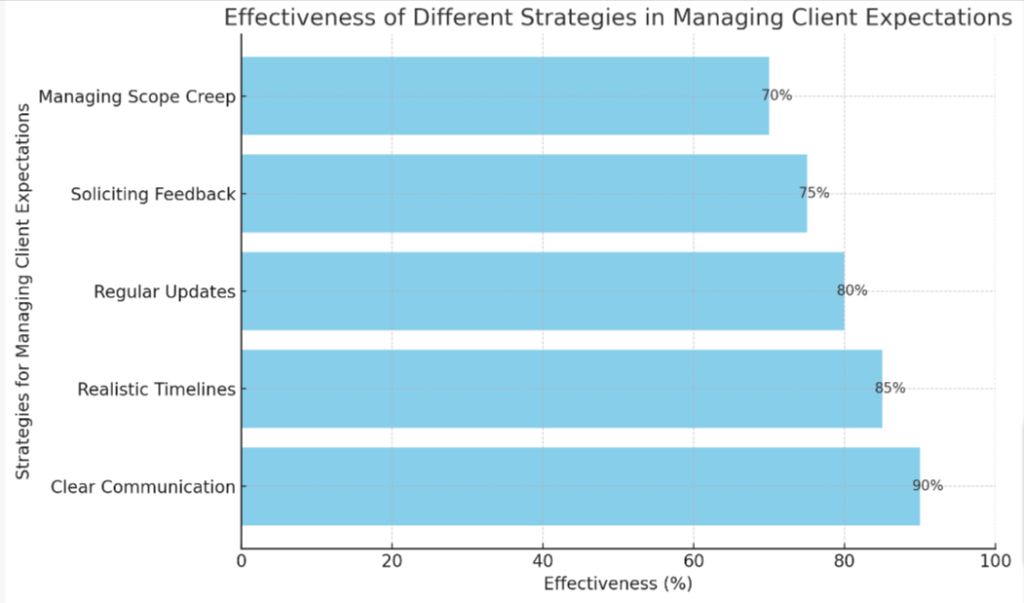The Secret to Client Retention: Managing Expectations Effectively
Are you struggling to keep clients content and retain their business over the long term? It’s a common challenge, considering 68% of customers leave a company due to poor service or mismanaged expectations.
This article will offer valuable insights on how understanding client expectations and managing them effectively can foster enduring partnerships. Dive in, and discover how mastering client-expectations management is crucial for your sustained success!
Key Takeaways
- Understanding the differences between client and customer expectations is crucial for effective relationship management.
- Addressing changes in client expectations as they arise helps maintain satisfaction and build long – term relationships.
- Prioritizing regular and proactive communication, setting realistic goals, combining pricing with a documented scope of work, providing access to project tools, and avoiding difficult clients are strategies for managing client expectations during a project.
- Client retention is important for business growth and relies on developing trust, emotional connection, and strong communication channels.
Understanding Client Expectations
Client expectations can vary greatly from customer expectations, and it is crucial to identify the common challenges and address changes as they arise.
The differences between client and customer expectations
Clients and customers both affect a business’ success, but their expectations significantly differ. Buyers or users of a product or service are typically referred to as customers. They expect quality, cost-effectiveness, and promptness in the delivery of what they’ve paid for.
Clients, on the other hand, usually engage in ongoing relationships with businesses for tailored services. Their expectations stretch beyond transactional aspects into areas such as personalized attention, reliable support, dedicated account management and timely response to queries or problems – advocating more relationship-focused interactions rather than solely transaction-based ones.
These differing needs mandate varied strategic approaches to ensure satisfaction across both categories: customer and client.
Identifying common challenges
Every business, no matter the industry, encounters a set of common challenges when managing client expectations. These include:
- Miscommunication
- Unrealistic Deadlines
- Budget Constraints
- Lack of Trust
- Continual Changes
- High Maintenance Clients
- Loss of Repeat Business
Addressing changes in expectations as they arise
Client expectations can shift over the life of a project. Addressing these changes as they occur is critical for maintaining client satisfaction and building long-term relationships.
- Regularly check – in with clients to stay updated on their changing needs or goals
- Always keep lines of communication open and encourage clients to voice any concerns or changes in their expectations
- Utilize feedback mechanisms such as surveys or questionnaires to gauge client’s evolving expectations
- Revisit and revise project goals, if necessary, in response to changes in client’s expectations
- Use transparent and clear communication to explain how any changes will affect the project timeline, budget, or outcomes
- Employ effective problem – solving strategies when adjusting the project plan due to a change in client expectations
- Be proactive in identifying potential shifts in client’s expectations by staying in tune with market trends and industry developments.
- Keep your team informed about any changes so everyone understands the new scope of work or objectives
- Prepare contingency plans to ensure a smooth transition if an unexpected shift in client expectation occurs.
Strategies for Managing Client Expectations During a Project
Regular and proactive communication is essential for managing client expectations during a project.
Prioritizing regular and proactive communication
Regular and proactive communication is a crucial element in managing client expectations. By staying in constant contact with clients, you can keep them informed about the progress of their project, address any concerns or changes in expectations as they arise, and ensure that everyone is on the same page.
This approach helps to build trust, maintain transparency, and foster a positive working relationship. Additionally, it allows you to promptly identify and resolve any issues before they escalate.
Through consistent communication, you can provide reassurance to your clients and demonstrate your commitment to meeting their needs effectively.
Setting realistic goals and milestones
Setting realistic goals and milestones is essential for effective client management and building long-term relationships. This ensures that both parties are on the same page and have a clear understanding of what needs to be achieved. Key strategies for setting realistic goals and milestones include:
- Collaborating with clients to define specific, measurable, attainable, relevant, and time – bound (SMART) goals.
- Breaking larger goals into smaller, manageable milestones.
- Regularly reviewing progress against goals and adjusting as needed.
- Communicating any challenges or changes in scope that may impact the timeline or deliverables.
- Celebrating achievements when milestones are reached.
Combining pricing with a documented scope of work
Combining pricing with a documented scope of work is an essential strategy for managing client expectations during a project. By clearly outlining the costs and deliverables in a written agreement, both parties have a mutual understanding of what is expected and can avoid any misunderstandings or disputes later on.
This approach helps to set realistic goals and budget constraints upfront, ensuring that everyone is on the same page from the beginning. It also provides transparency and accountability throughout the project, allowing clients to see exactly what they are paying for and what they can expect to receive in return.
By combining pricing with a documented scope of work, businesses can effectively manage client expectations and foster stronger long-term relationships.
Providing access to project tools for full visibility
Clients appreciate being able to stay informed and involved throughout the duration of a project. By providing access to project tools, you can offer them full visibility into the progress and status of their project.
This transparency builds trust and confidence as clients can monitor milestones, track deliverables, and gain real-time insights into the work being done. It also allows for open communication and collaboration between you and your clients, ensuring that everyone is on the same page.
With easy access to project tools, clients feel empowered and engaged in the process, resulting in a stronger relationship based on transparency and effective communication.
Looking out for red flags and avoiding difficult clients
Identifying potential red flags and avoiding difficult clients is essential for maintaining successful long-term relationships. Watch out for signs such as unrealistic expectations, frequent changes in project scope, or a history of poor communication.
These indicators can save you time and energy by steering clear of clients who may pose challenges or create unnecessary stress. By being proactive in your approach to client management, you can focus on building partnerships that are mutually beneficial and promote growth for both parties involved.
The Importance of Client Retention in Building Long-Term Relationships
Client retention plays a critical role in fostering long-term relationships, driving business growth, and creating a foundation of trust and loyalty.
The impact of client retention on business growth
Client retention plays a crucial role in driving business growth. When businesses are able to retain their clients, they can benefit from repeat business and customer loyalty. This leads to increased revenue and profitability over time.
By maintaining strong relationships with existing clients, businesses can also save on marketing costs associated with acquiring new customers. Additionally, satisfied clients are more likely to recommend the business to others, which further contributes to growth.
Therefore, prioritizing client retention is essential for long-term success and sustainable business growth.
The psychology behind client retention
Understanding the psychology behind client retention is crucial for building long-term relationships. It goes beyond just providing excellent service and meeting customer expectations.
Client retention is about developing a deep emotional connection with clients, gaining their trust, and fostering a sense of loyalty. When clients feel valued, understood, and appreciated, they are more likely to stay committed to a business or service provider.
By understanding the psychological factors that drive client retention, businesses can tailor their strategies to align with these needs and create an environment where clients want to stay for the long haul.
The role of trust and emotional connection
Trust and emotional connection play a crucial role in building and maintaining long-term relationships with clients. When clients trust you, they are more likely to view you as a reliable partner and feel confident in your ability to meet their needs.
This trust is built through consistent communication, delivering on promises, and demonstrating that you understand their goals and challenges. Additionally, establishing an emotional connection helps foster a sense of loyalty and commitment from clients, as they value the relationship beyond just the services or products provided.
By prioritizing trust-building efforts and fostering emotional connections with your clients, you can cultivate strong and lasting partnerships that contribute to the success of both parties involved.
Proven Methods for Client Retention
Build strong communication channels, deliver consistent high-quality service, personalize client experiences, overcome challenges, and measure and improve strategies. Read more to discover effective methods for retaining clients and building long-term relationships.
Building strong communication channels
To maintain long-term relationships with clients, it is crucial to build strong communication channels. This involves:
- Regularly and proactively reaching out to clients.
- Actively listening to their feedback and concerns.
- Providing updates on project progress and milestones.
- Being available and responsive to their calls and emails.
- Using a variety of communication methods that suit their preferences (e.g. phone calls, emails, video conferences).
- Ensuring clarity in all communications by using simple and concise language.
- Asking for clarification when needed to avoid misunderstandings.
- Being transparent about any challenges or issues that may arise during the project.
- Seeking their input and involving them in decision – making processes.
Delivering consistent and high-quality service
Consistency and quality are the cornerstones of building strong client relationships. By consistently delivering high-quality service, you will establish trust and satisfaction with your clients.
This means consistently meeting deadlines, delivering on promises, and exceeding expectations. When you prioritize providing exceptional service at every touchpoint, from initial contact to project completion, you create a positive experience that keeps clients coming back for more.
By maintaining a consistent level of excellence in your work, you demonstrate professionalism and reliability, which further strengthens the foundation of your long-term relationships with clients.
Personalizing client experiences
To build strong and long-lasting relationships with your clients, it’s crucial to personalize their experiences. By taking the time to understand their unique needs and preferences, you can tailor your approach and deliver a more personalized service.
This includes customizing communication methods, offering personalized recommendations, and providing solutions that directly address their specific challenges. Personalization shows clients that you value them as individuals and goes a long way in building trust and loyalty.
It creates a positive impression that sets you apart from competitors by making clients feel seen, heard, and well taken care of throughout their journey with your business.
Overcoming challenges
To overcome challenges in managing client expectations, you can:
- Identify potential issues early on and address them proactively.
- Adapt your approach to meet changing client needs.
- Communicate openly and honestly with clients to build trust.
- Develop clear strategies for managing scope creep and budget constraints.
- Seek feedback from clients and make necessary adjustments.
- Continuously improve your processes and services based on client feedback.
- Build strong relationships with clients by going above and beyond to meet their needs.
- Handle difficult situations professionally and find mutually beneficial solutions.
Measuring and improving strategies
To ensure long-term success in managing client expectations, it is essential to continuously measure and improve your strategies. Here are some key approaches you can take:
- Conduct regular client satisfaction surveys to gather feedback and identify areas for improvement.
- Analyze data from previous projects or interactions to identify patterns and trends in client satisfaction.
- Seek input from your team members who work closely with clients to gain valuable insights and suggestions.
- Continuously monitor and evaluate the effectiveness of your communication channels and adjust as needed.
- Implement a system for tracking and measuring project performance against client expectations.
- Regularly review and update your goals based on feedback from clients, ensuring they remain realistic and align with their evolving needs.
- Invest in ongoing training and development for your team to enhance their skills in relationship management and customer satisfaction.

Conclusion: Implementing Effective Client Management Techniques for Long-Term Success
Implementing effective client management techniques is crucial for long-term success and building strong relationships. By understanding and addressing client expectations, prioritizing communication, setting realistic goals, and delivering consistent high-quality service, businesses can ensure client satisfaction and retention.
With proactive strategies in place, businesses can foster trust, loyalty, and partnership development for continued success.

